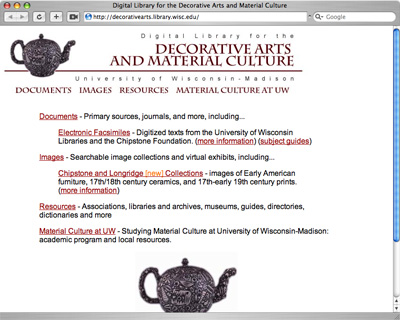Digital Library for the Decorative Arts and Material Culture

The Common-place Web Library reviews and lists online resources and Websites likely to be of interest to our viewers. Each quarterly issue will feature one or more brief site reviews. The library itself will be an ongoing enterprise with regular new additions and amendments. So we encourage you to check it frequently. At the moment, the library is small, but with your help we expect it to grow rapidly. If you have suggestions for the Web Library, or for site reviews, please forward them to the Administrative Editor.
Digital Library for the Decorative Arts and Material Culture
http://digital.library.wisc.edu/1711.dl/DLDecArts
For years, those wanting to examine historical artifacts closely had two options. They could travel to the appropriate museums and view the objects from a distance or study small pictures in exhibition catalogues. With its online visual database, the Digital Library for the Decorative Arts and Material Culture presents an efficient and powerful alternative for exhibiting artifacts. Part of the University of Wisconsin’s series of digital collections, the library provides a digitized record of seventeenth- through nineteenth-century Anglo-American ceramics, furniture, and prints from the Chipstone Foundation and the Longridge Ceramics Collection. The result is an accessible and engaging model for the online presentation of historical objects.
The Website’s design is sharp and plain, with a clear and uncluttered layout that scales easily to fit different desktop resolutions. The site’s simplicity should make navigation easy for all visitors, and it helps images and text load quickly on a broadband connection. Along with the library’s own exhibits, the site has links to other collections of historical documents and images.
The library site makes an impressive presentation of its nearly one thousand artifacts. The collections are searchable by keyword, and because of thorough annotation, searches based on city of origin, material, or subject matter produce accurate results, listed with helpful thumbnail images. For instance, a follow-up search on a teapot featuring an English lion returned a list of other items depicting the animal. Searching for date ranges is slightly more difficult, and there is little editorial guidance besides a brief list of subject headings, although plans are under way to add more scholarly documentation in future versions. In each collection, the photography is first-rate. Clear, focused, full-color images accompany entries and are viewable from four different resolutions. The objects were captured in bright, even light against a plain background, many from multiple views. The high quality allows visitors more access than they might have visiting the artifacts in person, showing such details as imperfections in pottery glaze or the interior cabinet compartments of a writing desk.
A wide variety of colorful and interesting artifacts are on display. Ceramics include an array of British tableware as well as candlesticks, flower vases, jugs, and small sculptures in different clays and glazes. Most are vibrantly decorated with geometric designs, floral tracery, and nationalist or religious symbols. The furniture is largely American and features tables, chests, desks, trunks, mirrors, and clocks. The pieces are very well preserved, and many reveal a high degree of craftsmanship and complexity. The print collection is small and less remarkable, with landscapes, city views, portraits, and political cartoons, but it does contain some iconic images by Paul Revere and William Hogarth.
Digitized versions of eighteenth- and nineteenth-century books on material culture round out the site’s holdings. Subjects covered include architecture, fashion, antiquities, the arts, and natural history. Most are available in full, searchable text, with a linked table of contents and a brief statement of historical context. Reproductions of book leaves maintain the high image quality of the site’s photographs, many in full color. Again the highest resolutions are revealing enough even to show brush strokes and paper textures. A helpful sidebar contains quick links for plain-text versions of each page and print-ready images.
This small collection contains a wealth of insights into the visual tastes of the past. Some are scholarly volumes, like eighteenth-century architect Robert Adam’s sumptuously illustrated review of Roman ruins, many with an emphasis on the exotic foreign motifs. Others, with ample engravings, like The American Builder’s Companion or The English Lady’s Costume, are practical nineteenth-century guides. Many of the visual standouts come from works on natural history. George Edward’s series The Natural History of Birds alone has over 350 full-color plates, and similar works on ornithology and botany carry equally lavish illustrations. The collection also has complete runs of the 1860s American art journal The New Path and the early twentieth-century folk art magazine The Craftsman.
The Digital Library provides an adept and accessible example for how other small institutions might make their material holdings available to a wider audience. The detailed photography and careful cataloguing allow both serious researchers and casual viewers to closely and quickly appreciate the colors, textures, and contours of historical artifacts. Those visitors who might before have pressed up tight against the museum glass now need only to click their mice for a better view.
This article originally appeared in issue 7.4 (July, 2007).
James Coltrain is a doctoral candidate at Northwestern University. His dissertation examines how the architecture of eighteenth-century North American forts shaped local views of European empires.
